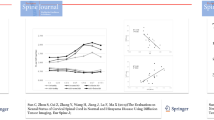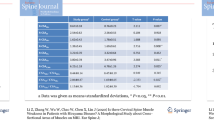Abstract
Objective
To quantify the cervical sagittal alignment in patients with Hirayama disease (HD) and to investigate the effect of loss of cervical sagittal alignment upon the cervical spinal lesions in HD.
Methods
Cervical sagittal alignments were measured in 253 HD patients and 63 healthy subjects by C2–C7 Cobb and a modified method of Toyama et al. Motor unit number estimation (MUNE) was performed in bilateral abductor pollicis brevis (APB) in all HD patients, and 31 patients further underwent cervical diffusion tensor imaging (DTI).
Results
Compared with healthy subjects, HD patients showed lower C2–C7 Cobb (P < 0.05), and 83.4% patients showed loss of cervical lordosis (cervical straight or kyphosis), which was greater than healthy subjects (55.6%, P < 0.05). Compared with lordotic/straight group, patients with cervical kyphosis showed lower MUNE values and greater single motor unit potential (SMUP) in bilateral APB, and higher apparent dispersion coefficient (ADC) and lower fractional anisotropy were observed at C4/C5 level in the latter than the former (P < 0.05). C2–C7 Cobb was associated with both C4/C5 ADC and bilateral SMUP (P < 0.05).
Conclusions
Most HD patients showed loss of cervical sagittal alignments, and both MUNE and DTI detections demonstrated a positive correlation between loss of cervical sagittal alignments and cervical spinal lesions in HD. These findings supported that loss of cervical sagittal alignments may worsen motor impairments in HD. Therefore, it is necessary for clinicians to be aware of restoring cervical sagittal alignments during HD treatment.



Similar content being viewed by others
Data availability
All data generated or analyzed during this study are included in this published article (and its supplementary material).
References
Lyu F, Zheng C, Wang H, Nie C, Ma X, Xia X, Zhu W, Jin X, Hu Y, Sun Y, Zhu Y, Kuwabara S, Cortese R, Maqbool Hassan K, Takai K, Paredes I, Webere R, Turk M, Kimura J, Jiang J (2020) Establishment of a clinician-led guideline on the diagnosis and treatment of Hirayama disease using a modified Delphi technique. Clin Neurophysiol 131:1311–1319. https://doi.org/10.1016/j.clinph.2020.02.022
Hirayama K, Tomonaga M, Kitano K, Yamada T, Kojima S, Arai K (1987) Focal cervical poliopathy causing juvenile muscular atrophy of distal upper extremity: a pathological study. J Neurol Neurosurg Psychiatry 50:285–290. https://doi.org/10.1136/jnnp.50.3.285
Bland JH (1994) Disorders of the cervical spine: diagnosis and medical management, 2nd edn. Saunders, Philadelphia
Toma S, Shiozawa Z (1995) Amyotrophic cervical myelopathy in adolescence. J Neurol Neurosurg Psychiatry 58:56–64. https://doi.org/10.1136/jnnp.58.1.56
Kohno M, Takahashi H, Yagishita A, Tanabe H (1998) “Disproportion theory” of the cervical spine and spinal cord in patients with juvenile cervical flexion myelopathy. A study comparing cervical magnetic resonance images with those of normal controls. Surg Neurol 50:421–430. https://doi.org/10.1016/s0090-3019(97)00451-5
Chen CJ, Hsu HL, Tseng YC, Lyu RK, Chen CM, Huang YC, Wang LJ, Wong YC, See LC (2004) Hirayama flexion myelopathy: neutral-position MR imaging findings–importance of loss of attachment. Radiology 231:39–44. https://doi.org/10.1148/radiol.2311030004
Fu Y, Fan DS, Pei XL, Han HB, Zhang J (2006) Neutral position magnetic resonance imaging for diagnosis of Hirayama disease [in Chinese]. Zhonghua Nei Ke Za Zhi 45:573–575
Ohara A, Miyamoto K, Naganawa T, Matsumoto K, Shimizu K (2006) Reliabilities of and correlations among five standard methods of assessing the sagittal alignment of the cervical spine. Spine (Phila Pa 1976) 31:2585–2591. https://doi.org/10.1097/01.brs.0000240656.79060.18
Sun C, Zhou S, Cui Z, Zhang Y, Wang H, Jiang J, Lu F, Ma X (2019) The evaluation on neural status of cervical spinal cord in normal and Hirayama disease using diffusion tensor imaging. Eur Spine J 28:1872–1878. https://doi.org/10.1007/s00586-019-06013-1
Zheng C, Zhu Y, Zhu D, Lu F, Xia X, Jiang J, Ma X (2017) Motor unit number estimation in the quantitative assessment of severity and progression of motor unit loss in Hirayama disease. Clin Neurophysiol 128:1008–1014. https://doi.org/10.1016/j.clinph.2017.03.007
Lehman VT, Luetmer PH, Sorenson EJ, Carter RE, Gupta V, Fletcher GP, Hu LS, Kotsenas AL (2013) Cervical spine MR imaging findings of patients with Hirayama disease in North America: a multisite study. AJNR Am J Neuroradiol 34:451–456. https://doi.org/10.3174/ajnr.A3277
Iacono S, Di Stefano V, Gagliardo A, Cannella R, Virzì V, Pagano S, Lupica A, Romano M, Brighina F (2022) Hirayama disease: Nosological classification and neuroimaging clues for diagnosis. J Neuroimaging 32:596–603. https://doi.org/10.1111/jon.12995
Xu X, Han H, Gao H, Hou C, Fan D, Fu Y, Sun Y (2011) The increased range of cervical flexed motion detected by radiographs in Hirayama disease. Eur J Radiol 78:82–86. https://doi.org/10.1016/j.ejrad.2010.08.012
Shin JJ (2019) Comparison of adjacent segment degeneration, cervical alignment, and clinical outcomes after one- and multilevel anterior cervical discectomy and fusion. Neurospine 16:589–600. https://doi.org/10.14245/ns.1938166.083
Hua W, Zhi J, Wang B, Ke W, Sun W, Yang S, Li L, Yang C (2020) Biomechanical evaluation of adjacent segment degeneration after one- or two-level anterior cervical discectomy and fusion versus cervical disc arthroplasty: A finite element analysis. Comput Methods Programs Biomed 189:105352. https://doi.org/10.1016/j.cmpb.2020.105352
Satake M, Kira J, Yoshimura T, Goto I, Tobimatsu S (1995) Segmental muscular atrophy of unilateral upper limb associated with cervical disc herniation in a juvenile male [in Japanese]. Rinsho Shinkeigaku 35:546–548
Hashimoto M, Yoshioka M, Sakimoto Y, Suzuki M (2012) A 20-year-old female with Hirayama disease complicated with dysplasia of the cervical vertebrae and degeneration of intervertebral discs. BMJ Case Rep. 2012:bcr2012006885. https://doi.org/10.1136/bcr-2012-006885
Shin Y, Han K, Lee YH (2020) Temporal trends in cervical spine curvature of South Korean adults assessed by deep learning system segmentation, 2006–2018. JAMA Netw Open 3:e2020961. https://doi.org/10.1001/jamanetworkopen.2020.20961
Lee SH, Hyun SJ, Jain A (2020) Cervical sagittal alignment: literature review and future directions. Neurospine 17:478–496. https://doi.org/10.14245/ns.2040392.196
Bao H, Varghese J, Lafage R, Liabaud B, Diebo B, Ramchandran S, Day L, Jalai C, Cruz D, Errico T, Protopsaltis T, Passias P, Buckland A, Qiu Y, Schwab F, Lafage V (2017) Principal radiographic characteristics for cervical spinal deformity: a health-related quality-of-life analysis. Spine (Phila Pa) 42:1375–1382. https://doi.org/10.1097/BRS.0000000000002144
Lau D, DiGiorgio AM, Chan AK, Dalle Ore CL, Virk MS, Chou D, Bisson EF, Mummaneni PV (2019) Applicability of cervical sagittal vertical axis, cervical lordosis, and T1 slope on pain and disability outcomes after anterior cervical discectomy and fusion in patients without deformity. J Neurosurg Spine 18:1–8. https://doi.org/10.3171/2019.7.SPINE19437
Di Stefano V, Thomas E, Giustino V, Iacono S, Torrente A, Pillitteri G, Gagliardo A, Lupica A, Palma A, Battaglia G, Brighina F (2022) Motor conduction studies and handgrip in hereditary TTR amyloidosis: simple tools to evaluate the upper limbs. Front Neurol 13:835812. https://doi.org/10.3389/fneur.2022.835812
Shefner JM, Watson ML, Simionescu L, Caress JB, Burns TM, Maragakis NJ, Benatar M, David WS, Sharma KR, Rutkove SB (2011) Multipoint incremental motor unit number estimation as an outcome measure in ALS. Neurology 77:235–241. https://doi.org/10.1212/WNL.0b013e318225aabf
Gawel M, Kostera-Pruszczyk A (2014) Effect of age and gender on the number of motor units in healthy subjects estimated by the multipoint incremental MUNE method. J Clin Neurophysiol 31:272–278. https://doi.org/10.1097/WNP.0000000000000066
Fukada K, Matsui T, Furuta M, Hirozawa D, Matsui M, Kajiyama Y, Shimizu M, Kinoshita M, Mochizuki H, Sawada JI, Hazama T (2016) The motor unit number index of subclinical abnormality in amyotrophic lateral sclerosis. J Clin Neurophysiol 33:564–568. https://doi.org/10.1097/WNP.0000000000000296
Bjugn R, Nyengaard JR, Rosland JH (1997) Spinal cord transection–no loss of distal ventral horn neurons. Modern stereological techniques reveal no transneuronal changes in the ventral horns of the mouse lumbar spinal cord after thoracic cord transection. Exp Neurol 148:179–186
Zheng C, Zhu Y, Lu F, Ma X, Tian D, Jiang J (2017) Trans-synaptic degeneration of motoneurons distal to chronic cervical spinal cord compression in cervical spondylotic myelopathy. Int J Neurosci 127:988–995. https://doi.org/10.1080/00207454.2017.1287701
Zhou B, Chen L, Fan D, Zhou D (2010) Clinical features of Hirayama disease in mainland China. Amyotroph Lateral Scler 11:133–139. https://doi.org/10.3109/17482960902912407
Zheng C, Zhu Y, Lu F, Zhu D, Yang S, Ma X, Xia X, Weber R, Jiang J (2017) Changes in the soleus H-reflex test and correlations between its results and dynamic magnetic resonance imaging abnormalities in patients with Hirayama disease. Clin Neurophysiol 128:2375–2381. https://doi.org/10.1016/j.clinph.2017.09.103
MeentVanDe H, Hosman AJ, Hendriks J, Zwarts M, EM-SCI Study Group, Schubert M (2010) Severe degeneration of peripheral motor axons after spinal cord injury: a European multicenter study in 345 patients. Neurorehabil Neural Repair 24:657–665. https://doi.org/10.1177/1545968310368534
Sawai S, Misawa S, Kanai K, Isose S, Shibuya K, Noto Y, Fujimaki Y, Sekiguchi Y, Nasu S, Nomura F, Kuwabara S (2011) Altered axonal excitability properties in juvenile muscular atrophy of distal upper extremity (Hirayama disease). Clin Neurophysiol 122:205–209. https://doi.org/10.1016/j.clinph.2010.06.015
Zheng C, Nie C, Lei W, Zhu Y, Zhu D, Wang H, Lu F, Weber R, Jiang J (2018) CAN anterior cervical fusion procedures prevent the progression of the natural course of Hirayama disease? An ambispective cohort analysis. Clin Neurophysiol 129:2341–2349. https://doi.org/10.1016/j.clinph.2018.08.024
Funding
This work was supported by Shanghai “Science and Technology Innovation Action Plan” Project (22s31900600) and the National Natural Science Foundation of China Science Foundation Project (82072488).
Author information
Authors and Affiliations
Contributions
ZCJ and JJY have made substantial contributions to conception and design; CKW, YY, and SC have made substantial contributions to acquisition of data, or analysis and interpretation of data; ZY, WHL, and LFZ have been involved in drafting the manuscript or revising it critically for important intellectual content; all authors have given final approval of the version to be published.
Corresponding authors
Ethics declarations
Ethics approval and consent to participate
This study protocol was approved by the Ethics Committee of Huashan Hospital (Fudan University, Shanghai, China) (KY2022-683), and informed consent was obtained from all participants. The procedures used in this study adhere to the tenets of the Declaration of Helsinki.
Consent for publication
Additional informed consent was obtained from all individual participants for whom identifying information is included in this article.
Conflict of interest
The authors declare no competing interests.
Additional information
Publisher's note
Springer Nature remains neutral with regard to jurisdictional claims in published maps and institutional affiliations.
Kaiwen Chen, Yang Yang, and Chi Sun contributed equally to this work and should be considered co-first authors.
Supplementary Information
Below is the link to the electronic supplementary material.

ESM 2
Supplementary Fig. 1: Correlation between HGS and MUNE measurements in the ipsilateral APB in HD patients. HGS was associated with CMAP amplitudes (A, D), average SMUP amplitudes (B, E) and MUNE values (C, F) in the ipsilateral APB. HD: Hirayama disease; MUNE: Motor unit number estimation; CMAP: Compound muscle action potential; SMUP: Single motor unit potential; HGS: Handgrip strength; APB: Abductor pollicis brevis. (PNG 3349 kb)

ESM 3
Supplementary Fig. 2: Correlation between DASH scores and MUNE measurements in HD patients. DASH was associated with CMAP amplitudes (A, D), average SMUP amplitudes (B, E) and MUNE values (C, F) on both sides. HD: Hirayama disease; MUNE: Motor unit number estimation; CMAP: Compound muscle action potential; SMUP: Single motor unit potential; DASH: The disabilities of the arm, shoulder and hand outcome measure.(PNG 2794 kb)
Rights and permissions
Springer Nature or its licensor (e.g. a society or other partner) holds exclusive rights to this article under a publishing agreement with the author(s) or other rightsholder(s); author self-archiving of the accepted manuscript version of this article is solely governed by the terms of such publishing agreement and applicable law.
About this article
Cite this article
Chen, K., Yang, Y., Sun, C. et al. Loss of cervical sagittal alignment worsens the cervical spinal lesions in patients with Hirayama disease. Neurol Sci 44, 2103–2111 (2023). https://doi.org/10.1007/s10072-023-06621-2
Received:
Accepted:
Published:
Issue Date:
DOI: https://doi.org/10.1007/s10072-023-06621-2




